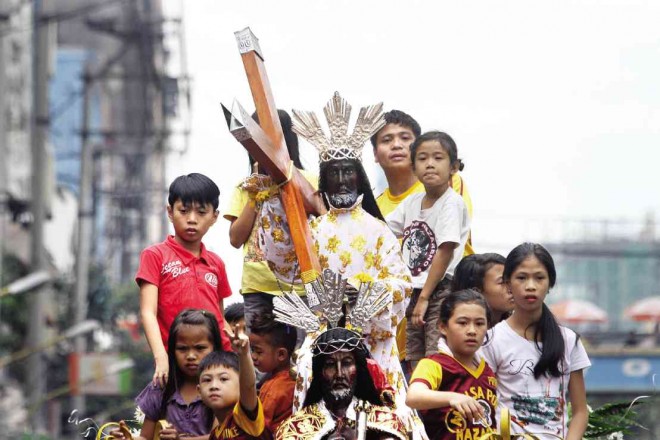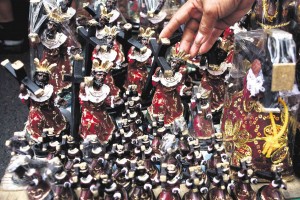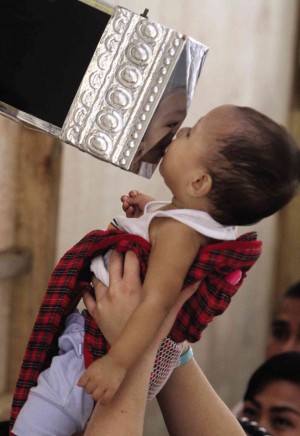DOH: Kids can get ‘tigdas’ in Quiapo rites

“SUFFER THE LITTLE CHILDREN” A replica of the Black Nazarene on its way to Rizal Park with some young companions on Tuesday seems to give flesh to Christ’s famous message about kids and their endearing innocence. NIÑO JESUS ORBETA
Spread the devotion, not the disease.
Citing the measles outbreak in the metropolis, the Department of Health (DOH) on Tuesday appealed to the millions of Black Nazarene devotees converging in Manila on Thursday not to bring children to the annual feast or just stay home if they themselves feel sick.
The warning was particularly addressed to pilgrims who, choosing tradition over precaution, expose children and infants to the mass ritual by letting them touch and even kiss the iconic image of the cross-bearing Christ.
The practice already started for many of the devotees Monday night, when organizers opened the “Pahalik” or the period during which the public can venerate the statue up close before tomorrow’s mammoth procession also known as the “Traslacion.”
The DOH reported a measles outbreak over the weekend in 10 areas in five cities in capital. Half of the 10 areas are in Manila, including Quiapo, home of the 17th century image.
Article continues after this advertisementHealth Assistant Secretary and National Epidemiology Center director Eric Tayag said children should be kept out of what is considered the biggest religious gathering in the country, especially now that it has the potential to spread measles, also known in Filipino as “tigdas.”
Article continues after this advertisement“Please don’t bring your children to the procession, especially five years old and below and those with fever or other symptoms of measles, to prevent the spread of the disease,” Tayag said.
An infected person could spread the virus to 18 people through coughing or direct contact with body secretions or fluids, and it may take several days from the time of the infection before symptoms, such as rashes, appear, he said.
Ailing adults also warned
“Our appeal is not only for kids. Adults who are not feeling well or those who have fever should better stay home and rest,” he added, noting that some ailing devotees force themselves to attend the procession in the belief that their participation could heal them.
Despite the DOH warning, early arrivals started streaming in, some with children in tow, either to give thanks for their improving health or to pray for healing.
Ma. Luisa Manio, a manicurist from Pasay City, said she started the devotion in 2010 when she experienced heavy menstrual bleeding that lasted for months.
Manio attributed the successful operation of her uterine polyps to the Nazarene. She has since joined the annual procession with husband Jose, a traffic marshal, himself a devotee for more than 30 years.
Lanie Granado, 31, came all the way from Bulacan province with her two children to touch the image and whisper prayers to the Nazarene, hoping this act of faith could put an end to her son’s frequent fever.
“I have strong faith in Him and I know that He will grant my prayers for my family,” she added.

ITSY-BITSY ICONS Vendors outside Quiapo Church in Manila cash in on the coming Black Nazarene procession by offering miniature versions of the image that draws millions of devotees each year. KIMBERLY DELA CRUZ
The Pahalik started a day ahead of schedule this year, according to Paul Hinlo, Traslacion 2014 head of security in charge of Quirino Grandstand at Rizal Park, where the Black Nazarene image was transferred from Quiapo Church Monday night.
He said the church rector, Msgr. Jose Clemente Ignacio, ordered the earlier start to allow more people to kiss and touch the image, which many believe to have miraculous powers.
“As for the security, we have already set up CCTV cameras last Sunday and there are roving K-9 units to secure the area surrounding the grandstand,” Hinlo explained.
The Pahalik ends Thursday morning, when the grand procession returns the image to Quiapo Church.
Not idol worship
Ignacio reminded devotees to show respect to the image by maintaining order during the procession, as he defended the Catholic tradition against critics who considered it a form of idolatry.
“We worship only one God. We don’t worship the statue, we venerate it,” Ignacio said during a recollection at Quirino Grandstand. The practice, he said, was similar to remembering deceased relatives through their pictures.
“A statue which has been blessed becomes an instrument of heaven. The Lord’s grace flows through the sacred object. Through the Nazarene, we can feel the presence of God,” Ignacio said.
“After the Mass, please respect the altar and allow the (statue) to pass through. Even if you can’t touch it, your mere presence will allow you to receive the grace,” he said.
